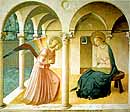Painter
Vicchio di Mugello 1400 ca.-Rome 1455
He first started painting in 1417 and shortly afterwards entered the Convent of San Domenico at Fiesole, eventually becoming its Prior. His first known works include some illuminated manuscripts and the Triptych of San Domenico (Museum of St. Mark), which still denotes Gothic trends as well as the clear influence of Lorenzo Monaco and Gentile da Fabriano.

Deposition in St.Trinita
From the time he painted the Triptych of San Pietro (1430, St.
Mark Museum) he was more and more influenced by the work of Masaccio,
whose plastic and spatial concepts were interpreted by Fra Angelico in
the form of light and colour.
He became the most important Florentine painter of his time after he completed
the famous Tabernacle of the Flax Dressers (1433, Museum
of St. Mark) together with other important wooden panels (the Polyptych of
Perugia, 1437; the St. Mark Altarpiece, 1438), where he tried to create the
foundations for a new form of religious art;
this was based on the ideals of the Renaissance though
its mystic content was more interested in creating an ideal beauty,
untouched by sin, rather than the exaltation of man, while its diaphanous
light was not a Gothic leftover but a very personal (and somewhat Dominican)
interpretation of the latest cultural ideas.

Annunciation
He moved to the convent of St. Mark in 1435, which had recently been transferred
to the Dominicans and was being restructured
thanks to the patronage of Cosimo dei Medici.
Here he was in charge of the fresco decorations in the building (1438-1446),
leaving masterpieces like the Annunciation and the Crucifixion in the Chapter
House. He gradually created a formal simplification of painting that was
in complete harmony with the plain architecture of Michelozzo.
Today the St. Mark Museum is really a museum
dedicated to the work of Fra Angelico.

